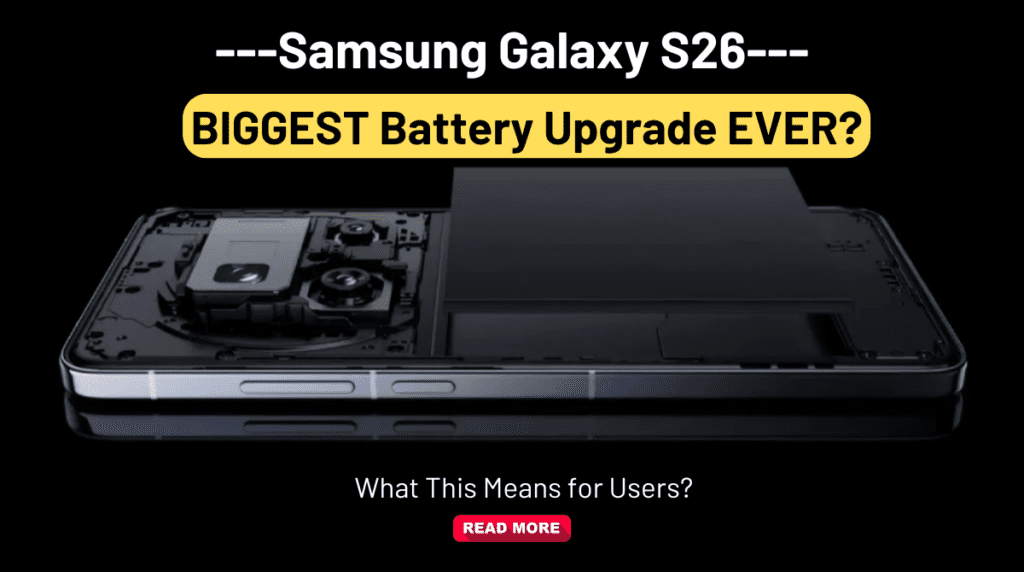Samsung is taking a bold step forward in battery technology with the Galaxy S26 series. The Korean tech giant is reportedly set to introduce silicon-carbon batteries, a revolutionary change that could significantly enhance battery life and performance. Reports suggest that the Galaxy S26 may feature a battery capacity of up to 7,000 mAh, marking a major leap from previous models. But what does this mean for users, and how will this impact the smartphone industry? Let’s dive deep into the upcoming flagship’s specifications, performance, and innovations.
What is Silicon-Carbon Battery Technology in the Galaxy S26?
Samsung is moving away from traditional lithium-ion batteries by integrating silicon-carbon technology in the Galaxy S26. This breakthrough battery design replaces graphite with silicon in the cathode material, increasing energy density and enabling longer-lasting power without significantly increasing battery size.
Advantages of Silicon-Carbon Batteries in the Galaxy S26
- Higher Capacity – The Galaxy S26 could potentially feature a 7,000 mAh battery, significantly surpassing previous models.
- Faster Charging – Silicon allows for improved conductivity, leading to shorter charging times compared to traditional lithium-ion batteries.
- Better Thermal Management – With silicon-carbon technology, heat dissipation improves, reducing the risk of overheating.
- Longer Lifespan – The battery is expected to retain its capacity longer, minimizing degradation over time.
Samsung’s shift towards silicon-carbon batteries comes after rival brands like Xiaomi, OnePlus, and vivo began experimenting with similar technology. However, Samsung’s challenge lies in mass production, as it manufactures significantly more units than its Chinese competitors.
Galaxy S26 Battery Performance: How Does It Compare?
Here’s a comparison of battery capacities across Samsung’s recent flagship models, highlighting the expected boost in the Galaxy S26:
| Model | Battery Capacity | Charging Speed |
|---|---|---|
| Galaxy S20 Ultra | 5,000 mAh | 45W |
| Galaxy S21 Ultra | 5,000 mAh | 45W |
| Galaxy S22 Ultra | 5,000 mAh | 45W |
| Galaxy S23 Ultra | 5,000 mAh | 45W |
| Galaxy S24 Ultra | 5,000 mAh | 45W |
| Galaxy S26 (Expected) | Up to 7,000 mAh | Faster than 45W |
Samsung’s charging speeds have remained at 25W and 45W for years, but with silicon-carbon batteries, we could see an improvement in fast charging capabilities.
Will the Galaxy S26 Finally Break Samsung’s 45W Charging Limit?
Despite its premium positioning, Samsung has limited its flagship devices to 45W fast charging, a stark contrast to competitors offering 100W+ charging speeds. The Galaxy S26 could change this trend, as silicon-carbon batteries enable higher power input without overheating or causing degradation.
However, Samsung may stick to a conservative approach, ensuring reliability and longevity rather than prioritizing extreme charging speeds. If rumors hold true, the Galaxy S26 Ultra could support at least 65W charging, a long-overdue upgrade.
Samsung Galaxy S26: Expected Specifications
While official details are yet to be confirmed, leaks suggest the Galaxy S26 will feature:
- Processor: Snapdragon 8 Gen 4 / Exynos 2500
- Battery: Up to 7,000 mAh (silicon-carbon technology)
- Charging Speed: Faster than 45W (possibly 65W)
- Display: 6.8-inch Dynamic AMOLED 2X, 144Hz refresh rate
- Camera: 200MP primary sensor, enhanced AI-powered photography
- Software: One UI 7 based on Android 15
Samsung’s Galaxy S26 Ultra is expected to retain its S-Pen integration, while the base Galaxy S26 and Galaxy S26+ models may feature minor design refinements.
Will Apple Follow Samsung in Adopting Silicon-Carbon Batteries?
With Samsung pioneering silicon-carbon battery technology in mass production, Apple may follow suit in future iPhone models. Reports suggest that Apple is considering using thinner silicon-based batteries for the iPhone 17 series. If Samsung successfully implements this technology in the Galaxy S26, it could set a new standard for the entire industry.
Should You Wait for the Galaxy S26?
If battery life is a top priority, the Galaxy S26 could be worth the wait. The potential 7,000 mAh battery and improved charging speeds make it a strong contender in the premium smartphone space.
With silicon-carbon batteries, Samsung is poised to revolutionize smartphone power efficiency. If successful, this innovation could mark the biggest leap in battery technology in years.
Would you upgrade to the Galaxy S26 for better battery performance? Let us know in the comments! 🚀
Also Read: Xiaomi Pad 7 Full Review: Camera and Conclusion
Looking for expert digital marketing services? Visit Pabale Digital now!”

